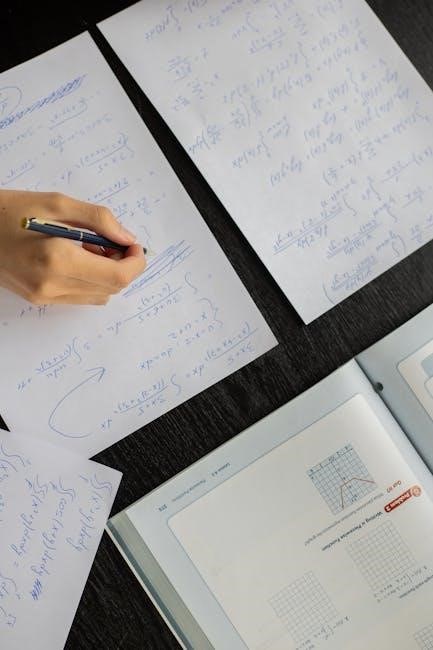Foundations of Math 11 introduces core mathematical concepts, emphasizing inductive and deductive reasoning, properties of angles and triangles, and proportional reasoning. It builds problem-solving skills and critical thinking, essential for real-world applications and future academic success.
1.1 Overview of the Course
The Foundations of Math 11 course is designed to develop essential mathematical skills, focusing on problem-solving and critical thinking. It covers key topics such as inductive and deductive reasoning, properties of angles and triangles, and proportional reasoning. The course is tailored for students pursuing careers in trades and technology, offering practical applications of math. It aligns with graduation requirements and provides a strong foundation for real-world problem-solving. Students engage with a comprehensive textbook and video-enhanced resources to deepen their understanding. The curriculum emphasizes logical reasoning and mathematical fluency, preparing students for diverse career pathways and lifelong learning.
1.2 Importance of the Course
Foundations of Math 11 is crucial for developing practical problem-solving skills and mathematical fluency. It focuses on real-world applications, making math relevant to everyday life and future careers. The course emphasizes logical reasoning and critical thinking, essential for success in trades, technology, and other professions. By mastering proportional reasoning and systems of equations, students gain a strong foundation for tackling complex challenges. This course also satisfies graduation requirements and prepares students for post-secondary pathways. Its practical approach ensures learners are equipped with skills that transcend academic settings, making it a vital component of their educational journey.

Course Structure
Foundations of Math 11 is structured to build skills progressively, focusing on proportional reasoning, systems of equations, and quadratics. The course includes video-enhanced resources, practice workbooks, and online tools to support learning. It is designed to help students connect mathematical concepts to real-world applications, ensuring a strong foundation for future studies and careers; The curriculum emphasizes logical progression, with each unit building on previous knowledge to enhance understanding and problem-solving abilities.
2.1 Course Outline
The course outline for Foundations of Math 11 is designed to provide a comprehensive understanding of mathematical concepts. It includes chapters on inductive and deductive reasoning, properties of angles and triangles, and proportional reasoning. Students explore systems of equations and quadratics, with practical applications in real-world scenarios. The curriculum is divided into units, each focusing on specific skills and problem-solving strategies. Additional resources, such as video-enhanced lessons and practice workbooks, support student learning. The course outline ensures a logical progression of topics, building from foundational concepts to more complex mathematical ideas. This structure helps students develop a strong mathematical foundation and prepares them for future academic and professional challenges.
2.2 Learning Targets
By the end of Foundations of Math 11, students will be able to apply inductive and deductive reasoning to solve problems. They will understand the properties of angles and triangles and use proportional reasoning to analyze relationships. Students will also solve systems of equations and work with quadratic expressions. The course aims to develop critical thinking and problem-solving skills, preparing students for real-world applications. Learning targets include analyzing data, interpreting graphs, and applying mathematical concepts to practical scenarios. Students will also demonstrate the ability to communicate mathematical ideas clearly and logically. These skills are essential for success in both academic and professional settings.
2.3 Video-Enhanced Features
The Foundations of Math 11 textbook incorporates video-enhanced features to support student learning. These videos provide detailed explanations of key concepts, such as systems of equations and quadratic functions. Interactive tutorials and animations help visualize complex ideas, making them easier to understand. The videos also include worked examples, allowing students to follow along and practice simultaneously. Additionally, some resources offer automatically graded exercises, enabling students to assess their understanding in real-time. These multimedia tools enhance engagement and provide flexibility for students to learn at their own pace, both in and out of the classroom. They are a valuable supplement to traditional textbook content.

Key Topics Covered
Foundations of Math 11 covers essential topics such as inductive and deductive reasoning, properties of angles and triangles, proportional reasoning, systems of equations, and quadratic functions. These concepts are vital for developing strong mathematical reasoning and problem-solving skills, preparing students for real-world applications and further studies.
3.1 Inductive and Deductive Reasoning
Inductive and deductive reasoning are fundamental concepts explored in Foundations of Math 11. Inductive reasoning involves making generalizations based on patterns or observations, while deductive reasoning applies general rules to specific cases to reach logical conclusions. These skills are essential for problem-solving and critical thinking. Students learn to analyze data, identify relationships, and form valid arguments. Through practical examples and exercises, the course helps develop the ability to reason mathematically, preparing students for real-world applications and further studies in mathematics. Mastering these reasoning techniques is crucial for tackling complex problems in various fields, from science to everyday decision-making.
3.2 Properties of Angles and Triangles
Foundations of Math 11 delves into the properties of angles and triangles, essential for understanding geometric relationships. Students explore types of angles, such as acute, obtuse, and right angles, and their measurements. The course also covers triangle classifications, including equilateral, isosceles, and scalene triangles, and their properties. Key concepts like angle sum, triangle inequality, and congruence are emphasized. Practical applications, such as calculating unknown sides or angles in real-world scenarios, are highlighted. These lessons provide a solid foundation for advanced topics like systems of equations and quadratics, ensuring students can apply geometric principles to solve complex problems effectively. This knowledge is crucial for developing spatial reasoning and problem-solving skills.
3.3 Proportional Reasoning
Proportional reasoning is a cornerstone of Foundations of Math 11, focusing on understanding rates, ratios, and percentages. Students learn to identify proportional relationships, solve problems involving direct and inverse proportions, and apply these concepts to real-world scenarios. The course emphasizes scaling in geometric figures and interpreting graphs to understand proportional changes. Practical applications include calculating unit rates, comparing quantities, and solving word problems involving proportional reasoning. This topic builds a strong foundation for advanced mathematical concepts and prepares students to tackle complex problems in fields like trades and technology. By mastering proportional reasoning, students enhance their analytical and problem-solving abilities, crucial for academic and professional success.

3.4 Systems of Equations
Systems of equations in Foundations of Math 11 introduce students to solving multiple equations with two or more variables. Emphasizing algebraic methods like substitution and elimination, the course helps students understand how to represent and solve real-world problems. Graphical interpretations are also explored to visualize solutions. Practical applications include modeling scenarios involving two variables, such as budgeting or resource allocation. This topic strengthens algebraic manipulation skills and reinforces problem-solving techniques. By mastering systems of equations, students gain confidence in tackling complex, multi-step problems and develop a deeper understanding of mathematical relationships in various contexts, preparing them for advanced math courses and real-world applications.
3.5 Quadratics
Quadratics in Foundations of Math 11 explore the properties and applications of quadratic equations and their graphs. Students learn to solve quadratic equations using factoring, the quadratic formula, and completing the square. The course emphasizes graphing quadratic functions, identifying vertex form, and analyzing parabolic shapes. Practical applications include modeling real-world phenomena, such as projectile motion and area optimization. By understanding quadratics, students develop essential skills in algebraic manipulation and problem-solving, preparing them for advanced math concepts and STEM-related fields. This unit bridges foundational math with practical, everyday scenarios, fostering a deeper appreciation for mathematical modeling and its versatility in solving complex problems.

Learning Resources
Foundations of Math 11 provides comprehensive resources, including textbooks, online tools, and video-enhanced features, to support student learning and understanding of key mathematical concepts and practical applications.
4.1 Textbook Details
The Foundations of Math 11 textbook, published by Nelson Education, is a comprehensive resource designed for Grade 11 students. Authored by Cathy Canavan-McGrath, Joanne Landry, Darlene Olson-St. Pierre, Sarah Wade, Karen Iversen, Gerry Varty, and others, it focuses on inductive and deductive reasoning, properties of angles and triangles, and proportional reasoning. The textbook is accompanied by workbooks and video-enhanced features to aid learning. Available in PDF format, it provides a structured approach to understanding mathematical concepts, making it an essential tool for students aiming to master foundational math skills. Additional resources, such as practice workbooks, are also available to supplement learning.
4.2 Online Resources and Tools
Supplementing the Foundations of Math 11 textbook, various online resources and tools are available to enhance learning. Video-enhanced features provide visual explanations of key concepts, while platforms like ThinkWell and MyMathsCloud offer multimedia lectures and interactive exercises. Pearson and Nelson Education websites host additional practice materials, including downloadable PDFs and quizzes. Interactive math drills and problem-solving activities are accessible through platforms like Big Ideas Math and Go Math. These resources cater to diverse learning styles, allowing students to reinforce their understanding of topics like proportional reasoning and systems of equations. Online forums and study groups also provide spaces for collaboration and problem discussion, fostering a deeper grasp of mathematical principles.
4.3 Practice Workbooks
Practice workbooks for Foundations of Math 11 are designed to reinforce learning through structured exercises. Resources like the HMH Go Math and Big Ideas Math workbooks provide chapter-wise solutions, enabling students to practice independently. These materials cover key topics such as proportional reasoning, systems of equations, and quadratic equations; The Math for Trades series and Go Math Textbook Answer Key PDFs offer additional practice problems, ensuring a strong foundation in mathematical concepts. By utilizing these workbooks, students can systematically review and master the curriculum, preparing effectively for assessments and real-world applications. Regular practice with these resources fosters confidence and proficiency in problem-solving.

Assessments and Evaluations
Assessments include quizzes, chapter tests, and final exams, aligned with learning targets. Regular practice and review are crucial for success in these evaluations.
5.1 Types of Assessments
The course includes a variety of assessments to evaluate student understanding, such as quizzes, chapter tests, and final exams. Quizzes are used to gauge progress throughout units, while chapter tests assess mastery of specific topics. Final exams comprehensively evaluate understanding of the entire curriculum. Additionally, video-enhanced features and online tools may be incorporated to provide interactive assessment opportunities. These evaluations are designed to align with the course’s learning targets, ensuring students demonstrate proficiency in problem-solving, critical thinking, and mathematical reasoning. Regular practice and review are essential for success in these assessments, as they measure both theoretical knowledge and practical application skills.
5.2 Importance of Regular Practice
Regular practice is crucial for mastering the concepts in Foundations of Math 11. It reinforces understanding of key topics like proportional reasoning and systems of equations, while improving problem-solving and critical thinking skills. Consistent practice helps students identify and address gaps in their knowledge, ensuring a strong foundation for future math courses. Additionally, it fosters confidence and fluency in applying mathematical concepts to real-world scenarios. By dedicating time to regular practice, students can better prepare for assessments and develop a deeper appreciation for the practical applications of mathematics in their everyday lives and future careers.

Common Challenges and Solutions
Students often struggle with proportional reasoning and systems of equations. To overcome these, use video resources, seek additional support, and practice consistently to build confidence and understanding of complex concepts.
6.1 Difficulties in Proportional Reasoning
Many students face challenges with proportional reasoning, particularly in understanding ratios, rates, and scaling factors. Difficulties often arise when applying proportional concepts to real-world problems or multi-step scenarios. Identifying equivalent ratios and recognizing proportional relationships can be confusing, especially when visual or graphical representations are involved. Additionally, students may struggle with inverse proportions and distinguishing between proportional and non-proportional situations; To address these challenges, breaking problems into smaller, manageable parts and using visual aids like diagrams or graphs can help clarify relationships and build a stronger foundation in proportional reasoning.
6.2 Strategies for Success
To excel in Foundations of Math 11, it is essential to adopt effective learning strategies. Consistent practice and review of concepts are crucial, as they reinforce understanding and build confidence. Leveraging video-enhanced resources and online tools can provide interactive learning experiences, making complex topics more engaging. Additionally, collaborative study groups and peer discussions can help clarify doubts and deepen comprehension. Regularly reviewing notes and seeking feedback from instructors ensure progress. By staying organized and proactive, students can master the course material and develop a strong mathematical foundation for future success.

Real-World Applications
Foundations of Math 11 concepts, such as proportional reasoning, are essential in trades and everyday life. Students learn to apply mathematical skills to real-world scenarios, preparing them for careers in construction, engineering, and more. The course emphasizes practical problem-solving, making math relevant and useful in daily tasks like budgeting and event planning.
7.1 Math in Trades
Math in trades relies heavily on concepts from Foundations of Math 11, such as proportional reasoning and systems of equations. Tradespeople use these skills for precise measurements, material estimation, and project budgeting. The course emphasizes practical applications, like calculating capacities, pressure, and total force, which are essential in fields like plumbing and engineering. Trigonometry is also crucial for understanding heights and angles in construction. By mastering these mathematical tools, students gain a strong foundation for careers in trades, enabling them to solve real-world problems efficiently and accurately. This connection between classroom learning and professional practice highlights the importance of math in everyday trade tasks.
7.2 Everyday Problem Solving
Foundations of Math 11 equips students with skills to tackle everyday challenges, such as budgeting, cooking, and financial decisions. Proportional reasoning aids in scaling recipes or comparing prices, while systems of equations help in balancing budgets and planning expenses. These mathematical tools enable individuals to make informed choices in daily life, from calculating discounts to understanding loan interest. By applying concepts like quadratics and trigonometry, students can solve problems related to home improvement, travel planning, and energy consumption. The course bridges academic learning with practical, real-world scenarios, fostering confidence in managing life’s mathematical demands effectively and efficiently.

Career Connections
Foundations of Math 11 connects mathematical concepts to various careers, including trades, engineering, and finance, preparing students for professional challenges and lifelong learning in diverse fields.
8.1 Trades and Technology
Foundations of Math 11 is essential for students pursuing careers in trades and technology, as it provides practical mathematical skills for problem-solving in real-world scenarios. The course covers topics like proportional reasoning, systems of equations, and properties of angles and triangles, which are crucial for professions such as carpentry, electrical work, and plumbing. Math for Trades: Volume 3 further enhances these skills with lessons on capacities, pressure, and trigonometry. By mastering these concepts, students gain the ability to calculate materials, understand blueprints, and apply mathematical principles to hands-on projects, making them well-prepared for apprenticeships or direct entry into the trades workforce.
8.2 Importance in Various Professions
Foundations of Math 11 is crucial for students aiming to excel in diverse professions requiring strong mathematical foundations. Engineers, architects, and physicists rely on concepts like proportional reasoning and systems of equations to design structures and analyze data. Economists use mathematical models to forecast trends, while computer scientists apply logical reasoning to develop algorithms. Even in healthcare, professionals use statistical analysis to interpret patient data. The course’s emphasis on problem-solving, logical thinking, and analytical skills prepares students for these demanding fields. By mastering these concepts, students gain a competitive edge, enabling them to tackle challenges in their chosen careers with confidence and precision.

Graduation Requirements
Completing Foundations of Math 11 satisfies the grade 11 or 12 math requirement for graduation, preparing students for post-secondary pathways and future career opportunities.
9.1 Course Benefits
Foundations of Math 11 provides students with a strong mathematical foundation, enhancing their problem-solving skills and critical thinking. It prepares them for various post-secondary pathways, including trades and technology, by focusing on real-world applications. The course emphasizes inductive and deductive reasoning, proportional reasoning, and systems of equations, ensuring practical knowledge. Additionally, the video-enhanced features and interactive resources support diverse learning styles. By mastering these concepts, students gain confidence in tackling mathematical challenges, making them more adaptable for future academic and professional pursuits.
9.2 Differences from Pre-Calculus
Foundations of Math 11 differs from Pre-Calculus 11 in its focus on practical applications and problem-solving rather than theoretical concepts. While Pre-Calculus emphasizes advanced algebraic manipulation, trigonometry, and preparation for calculus, Foundations of Math 11 concentrates on proportional reasoning, systems of equations, and quadratics with real-world relevance. This makes it ideal for students pursuing trades, technology, or other applied fields. The course structure and assessments in Foundations of Math 11 are tailored to enhance critical thinking and hands-on skills, whereas Pre-Calculus focuses on building a foundation for advanced mathematical studies.
Foundations of Math 11 provides a comprehensive understanding of essential mathematical concepts, equipping students with problem-solving skills and critical thinking. The course emphasizes real-world applications, making it ideal for students in trades and technology. By mastering topics like proportional reasoning, systems of equations, and quadratics, students gain a strong foundation for their future careers. The textbook and online resources offer robust support, ensuring students can thrive in their academic and professional pursuits. This course is a valuable stepping stone, preparing learners for the challenges of an increasingly math-dependent world.
